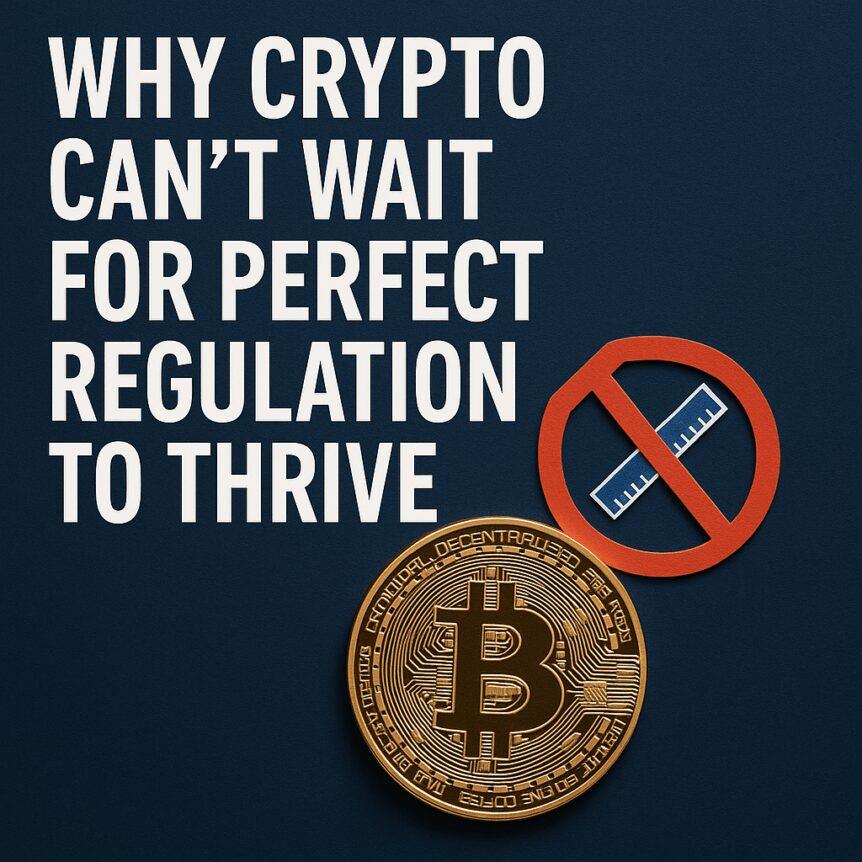Why Crypto Can't Wait For Perfect Regulation To Thrive
There's a sense of familiarity in today's crypto landscape. Terms like real-world assets (RWAs), tokenized funds, and onchain treasuries have been circulating for years. Back in 2022, projections by consulting firm BCG suggested the total value of tokenized assets could reach $16 trillion by 2030. Meanwhile, the current market cap hovers around $50 billion in 2025, reflecting a significant gap between hype and adoption.
However, this time feels different. Major financial players, such as BlackRock , are launching tokenized money market funds, and Circle 's USDC is emerging as the onchain settlement layer for U.S. Treasury bonds. The industry's narrative is aligning more closely with real-world applications-business operations, cash flows, and compliance-marking a crucial shift towards mainstream acceptance.
Despite this momentum, one obstacle remains a persistent drag: the pursuit of perfect regulation. The crypto industry often advocates for comprehensive, global frameworks, but the reality is far more complex. International financial regulations are often inconsistent-Basel III standards in Europe differ markedly from U.S. banking rules. Such fragmentation creates uncertainty, discouraging institutional participation and delaying progress across markets.

Examples across jurisdictions illustrate this reality. In the U.S., tokenized equities are classified as securities, while Europe's Markets in Crypto -Assets (MiCA) regulation offers an overarching blueprint, yet its scope remains limited-particularly in areas like decentralized finance (DeFi). Singapore facilitates tokenized bonds for institutional investors but restricts retail participation. These nuanced regulatory approaches highlight that evolution, rather than perfection, is key.
The Costs of InactionInstitutional hesitation isn't rooted in distrust of blockchain technology but in fears of legal and compliance repercussions. Overhauling existing systems is costly and risky, especially when regulators' guidance is ambiguous. Many firms grapple with the high costs of legal due diligence and legal risk management, which hampers cross-border liquidity and investment flows.
Without clear, pragmatic regulation, the operational costs and risks skyrocket. This systemic issue hampers the adoption of crypto assets and blockchain innovations, underscoring the urgent need for clearer guidelines that balance safeguards with practicality.
Clarity as a Catalyst for GrowthComplete global harmonization may be an unattainable goal in the short term, but the industry does not need perfect regulation to unlock massive potential. Traditional finance has operated amid fragmented regulatory landscapes for decades, with shadow banking-and its $60 trillion market-thriving despite imperfect oversight.
What's critical is establishing a baseline of regulatory clarity-guidelines that enable firms to assess, manage risk, and deploy capital confidently. Iterative rule-making, even if imperfect, is preferable to stagnation.
Tokenization's Promise and Practical ProgressThe true value of tokenization lies in solving tangible problems: reducing settlement times, freeing up capital, and bridging jurisdictional barriers. When regulators provide a modicum of clarity, adoption accelerates-demonstrated by stablecoins and security tokens already gaining traction.
This isn't about abandoning safeguards but recognizing that incremental progress is integral to the evolution of crypto markets. The next phase of finance depends on the willingness of regulators and institutions to embrace ongoing refinement rather than waiting for an impossible ideal.
From Vision to RealityToday's crypto industry is moving beyond speculation. Profit-generating businesses are processing real money onchain, signaling the importance of embracing practical regulation. Firms that act now within attainable legal frameworks will shape the future of digital assets and blockchain innovation, advancing a more inclusive, efficient financial system.
Progress is about momentum-not perfection. Waiting for perfect regulatory clarity risks leaving innovation on the sidelines, prolonging the transformation that digital assets promise.
Opinion by: Kevin de Patoul, co-founder and CEO of Keyrock.
Crypto Investing Risk Warning
Crypto assets are highly volatile. Your capital is at risk. Don't invest unless you're prepared to lose all the money you invest.
Legal Disclaimer:
MENAFN provides the
information “as is” without warranty of any kind. We do not accept
any responsibility or liability for the accuracy, content, images,
videos, licenses, completeness, legality, or reliability of the information
contained in this article. If you have any complaints or copyright
issues related to this article, kindly contact the provider above.
Most popular stories
Market Research

- Jpmorgan Product Head Joins GSR Trading MD To Build Institutional Staking Markets
- Kintsu Launches Shype On Hyperliquid
- R0AR Launches Buyback Vault: Bringing 1R0R To R0AR Chain Unlocks New Incentives
- Excellion Finance Scales Market-Neutral Defi Strategies With Fordefi's MPC Wallet
- Ethereum-Based Meme Project Pepeto ($PEPETO) Surges Past $6.5M In Presale
- Falcon Finance Unveils $FF Governance Token In Updated Whitepaper





















Comments
No comment